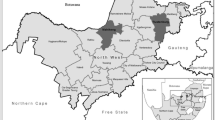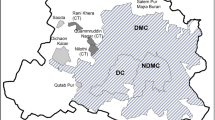Abstract
This paper provides a brief overview of the relevant post-2000 South African policy for regional (provincial) spatial development within the context of the quantitative findings of a study conducted on the growth potential of non-metropolitan settlements in the Western Cape. The findings are presented at municipal level. Five indices (social needs, economic, physical environment, infrastructure and institutional) and 69 indicators were used to determine development potential and social needs for the 24 local municipalities and three district management areas in the province. The potential indicators for each index were subjected to a factor analysis to select appropriate core indicators for inclusion in the composite indices. Based on their overall performance in the various indices, the municipalities were classified into three categories—high, medium and low. The study results prioritise areas according to their developmental potential and social needs at municipal level.






Similar content being viewed by others
References
Acton, C., Miller, R., Fullerton, D., & Maltby, J. (2009). SPSS for social scientists. Hampshire: Palgrave Macmillan.
Al-Najjar, B., & Alsyouf, I. (2003). Selecting the most efficient maintenance approach using fuzzy multiple criteria decision making. International Journal of Production Economics, 84(1), 85–100.
Atkinson, D. (2008). Promoting the second economy in small and medium-sized towns: A paper for the second economy strategy project: An initiative of the presidency. Pretoria: The Presidency.
Atkinson, D., & Marais, L. (2006). Urbanization and the future urban agenda in South Africa. In U. Pillay, R. Tomlinson, & J. Du Toit (Eds.), Democracy and delivery. Pretoria: HSRC Press.
Booysen, F. (2002). An overview and evaluation of composite indices of development. Social Indicators Research, 59(2), 115–151.
Bruno, R., Follador, M., Paegelow, M., Renno, F., & Villa, N. (2006). Integrating Remote Sensing, GIS and Prediction Models to Monitor the Deforestation and Erosion in Peten Reserve, Guatemala. Society for Mathematical Geology XIth International Congress, Université de Liège, Belgium.
Chang, K. (2006). Introduction to geographic information systems. New York: McGraw Hill.
DeMers, M. N. (2009). Fundamentals of geographic information systems. New York: Wiley.
Department of Trade and Industry. (2005). Integrated strategy on the promotion of entrepreneurship and small enterprises: Unlocking the potential of South African entrepreneurs. Pretoria: Department of Trade and Industry.
Donaldson, R. (2000). Urban restructuring through land development objectives in Pietersburg: An assessment. Journal of Public Administration, 35(1), 22–39.
Eastman, J. R. (2000). Decision strategies in GIS. Directions Magazine, December, s.p.
Ferreira, A. (2010). Cape of renewed growth, Times Live. [Online]. Available at: http://www.timeslive.co.za/business/article591039.ece/Cape-of-renewed-growth Accessed on 6 December 2011.
Gooch, J. T., & Manyathi, T. W. (2005). A strategic infrastructure plan for the Western Cape. Paper delivered at the 24th Southern African Transport Conference, Pretoria.
Grasso, M., & Canova, L. (2008). An assessment of the quality of life in the European Union based on the social indicators approach. Social Indicators Research, 87(1), 1–25.
Hadjimichalis, C. (2006). Non-economic factors in economic geography and in ‘new regionalism’: A sympathetic critique. International Journal of Urban and Regional Research, 30(3), 690–704.
Harrison, P., Todes, A., & Watson, V. (2008). Planning and transformation: Learning from post-apartheid experience. New York: Routledge.
Jenks, G. F. (1967). The data model concept in statistical mapping. International Yearbook of Cartography, 7, 186–190.
Kleynhans, E. P. J., Naude, W. A., & Van der Merwe, S. J. (2003). Spatial economic development in South Africa: An overview and evaluation of the platinum spatial development initiative. Development Southern Africa, 20(5), 617–631.
Luiz, J. M. (2003). The relevance, practicality and viability of spatial development initiatives: A South African case study. Public Administration and Development, 23(5), 433–443.
Mabin, A. (1992). Comprehensive segregation: The origins of the Group Areas Act and its planning apparatuses. Journal of Southern African Studies, 18(2), 405–429.
Mahini, A. S., & Gholamalifard, M. (2006). Siting MSW landfills with a weighted linear combination methodology in a GIS environment. International Journal of Environment, Science and Technology, 3(4), 435–445.
Makoni, E. N., Meiklejohn, C., & Coetzee, M. J. (2008). Distilling a ‘New Regionalist’ Planning Agenda for South Africa: Is the Provincial Growth and Development Strategy Measuring Up? Paper presented at the Planning Africa Conference on 14–16 April, held in Sandton, Johannesburg. [Online]. Available at: http://researchspace.csir.co.za/dspace/bitstream/10204/3086/1/Makoni1_2008.pdf Accessed 1 November 2011.
Malczewski, J. (1999). GIS and multi-criteria decision analysis. New York: John Wiley & Sons.
Ministry of Rural Development and Land Reform. (2009). The comprehensive rural development programme framework. Pretoria: Ministry of Rural Development and Land Reform.
National Planning Commission. (2011). National development plan. Vision for 2030. Pretoria: National Planning Commission.
Nel, E., & Rogerson, C. M. (2009). Re-thinking spatial inequalities in South Africa: Lessons from international experiences. Urban Forum, 20(2), 141–155.
Office of the Presidency (2003). National Spatial Development Perspective (NSDP). Pretoria: Office of the President.
Phua, M.-H., & Minowa, M. (2005). A GIS-based multi-criteria decision making approach to forest conservation planning at a landscape scale: A case study in the Kinabalu Area, Sabah, Malaysia. Landscape and Urban Planning, 71(2–4), 207–222.
Pieterse, E. (2008). Regional Development: Strategies for the future, in State of the Province Report 2008: Chapter 10. [Online]. Available from http://africancentreforcities.net/papers/4/ Accessed 1 September 2010.
Pike, A., Rodriguez-Pose, A., & Tomaney, J. (2006). Local and regional development. London: Routledge.
Province of the Western Cape. (2008). The iKapa growth and development strategy (iKapa GDS). Cape Town: Department of the Premier.
Republic of South Africa. (1996). Growth, employment and redistribution (GEAR): A macroeconomic strategy. Pretoria: Department of Finance.
Republic of South Africa. (2006). Annual report: Accelerated and Shared Growth Initiative for South Africa (ASGISA). Pretoria: The Presidency.
Republic of South Africa. (2009). National Urban Development Framework. Working draft (10 June 2009) for Consultation. Pretoria: Department of Cooperative Governance and Traditional Affairs and The Presidency.
Republic of South Africa. (2011). New growth path. Pretoria: Economic Development Department.
Rogerson, C. M. (1998). Restructuring the apartheid space economy. Regional Studies, 32(2), 187–197.
Rogerson, C. M. (1999). Planning spatial development initiatives: South Africa’s industrial development zones. Urban Forum, 10(2), 259–273.
Rogerson, C. M. (2008). Consolidating local economic development in post-apartheid South Africa. Urban Forum, 19(3), 307–328.
Rogerson, C. M. (2009). The turn to ‘New Regionalism’: South African reflections. Urban Forum, 20(2), 111–140.
Spocter, M. (forthcoming). Using geospatial data analysis and quantitative economic intelligence to inform local economic development in small towns: A case study of Graaff-Reinet, South Africa. In R. Donaldson and L. Marais (Eds.), Small Town Geographies in Africa: Experiences from South Africa and Elsewhere. New York: Nova Publishers.
Tomlinson, R. (1993). From regional planning to local development planning. Development South Africa, 10(2), 167–175.
Tomlinson, R., & Addleson, M. (Eds.). (1987). Regional restructuring under apartheid: Urban and regional policies in contemporary South Africa. Braamfontein: Ravan Press.
Turok, I. (2010). Towards a developmental state? Provincial economic policy in South Africa. Development Southern Africa, 27(4), 497–515.
Turok, I. (2011a). The new growth path: Implications for SA’s spatial economy. Paper presented at the UCT Graduate School of Business, Cape Town, 11 May.
Turok, I. (2011b). Spatial inequalities in South Africa: Towards a new research and policy agenda. Paper presented at the HSRC Social Sciences Conference, Birchwood Conference Centre, Benoni, 7–8 September.
Turok, I. (2011c). Spatial economic disparities in South Africa: Towards a new research and policy agenda. Paper presented at the Biennial Conference of the Economic Society of South Africa on 5 – 7 September, held in Stellenbosch, South Africa. [Online]. Available at: http://www.hsrc.ac.za/Document-4166.phtml Accessed 1 November 2011.
Turok, I., & Parnell, S. (2009). Reshaping cities, rebuilding nations: The role of national urban policies. Urban Forum, 20(2), 157–174.
Van der Merwe, J. H., & Von Holdt, D. S. (2006). Environmental footprint of aircraft noise exposure at Cape Town International Airport. The South African Geographical Journal, 88(2), 177–193.
Van der Merwe, I. J., Davids, A. J., Ferreira, S., Swart, G. P., & Zietsman, H. L. (2004). Growth potential of towns in the Western Cape. Stellenbosch: Centre for Geographical Analysis, University of Stellenbosch.
Van der Merwe, J. H., Ferreira, S. L. A., & Van Niekerk, A. (2008). A spatial gap-analysis of tourism development opportunity in the Western Cape province. Stellenbosch: Centre for Geographical Analysis, Stellenbosch University.
Van Huyssteen, E., Oranje, M., Robinson, S., & Makoni, E. (2009). South Africa’s city regions: A call for contemplation… and action. Urban Forum, 20(2), 175–194.
Van Huyssteen, E., Biermann, S., Naude, A., & le Roux, A. (2009). Advances in spatial analysis to support a more nuanced reading of the South African space economy. Urban Forum, 20(2), 195–214.
Van Niekerk, A. (2008). CLUES: A Web-based land use expert system for the Western Cape. PhD dissertation. Stellenbosch: Stellenbosch University.
Varma, V. K., Ferguson, I., & Wild, I. (2000). Decision support system for the sustainable forest management. Forest Ecology and Management, 128(1–2), 49–55.
Vreeker, R., Nijkamp, P., & Ter Welle, C. (2002). A multicriteria decision support methodology for evaluating airport expansion plans. Transportation Research, 7(1), 27–47.
Walker, M. (2001). Resource-based industrialisation strategies: A comparative analysis of the South African and international experience. South African Geographical Journal, 33(2), 93–104.
Wong, C. (2002). Developing indicators to inform local economic development in England. Urban Studies, 39(10), 1833–1863.
Wood, L. J., & Dragicevic, S. (2007). GIS-based multicriteria evaluation and fuzzy sets to identify priority sites for marine protection. Biodiversity and Conservation, 16(9), 2539–2558.
Yalcin, G., & Akyurek, Z. (2004). Analysing flood vulnerable areas with multicriteria evaluation. [Online]. Available at: http://cartesia.org/geodoc/isprs2004/comm2/papers/154.pdf Accessed 13 May 2008.
Acknowledgements
This research was funded by the Department of Environmental Affairs and Development Planning of the Western Cape government. We thank all the local municipalities of the Western Cape for providing the data used in the indicators employed.
Author information
Authors and Affiliations
Corresponding author
Rights and permissions
About this article
Cite this article
Donaldson, R., van Niekerk, A., du Plessis, D. et al. Non-metropolitan Growth Potential of Western Cape Municipalities. Urban Forum 23, 367–389 (2012). https://doi.org/10.1007/s12132-011-9139-4
Published:
Issue Date:
DOI: https://doi.org/10.1007/s12132-011-9139-4




